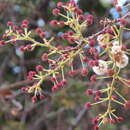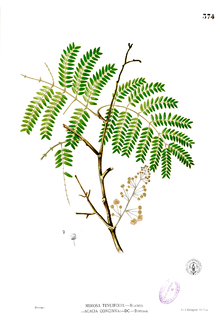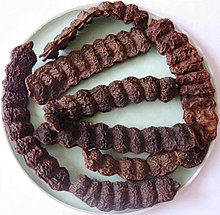mk
имиња во трошки


Acacia concinna (lat. Acacia concinna) - paxlakimilər fəsiləsinin akasiya cinsinə aid bitki növü.
Acacia concinna (lat. Acacia concinna) - paxlakimilər fəsiləsinin akasiya cinsinə aid bitki növü.
Acacia concinna ist eine Pflanzenart aus der Gattung der Akazien (Acacia). Ihr Verbreitungsgebiet liegt im tropischen Asien.[1]
Acacia concinna wächst als kletternder oder locker ausgebreitet wachsender Strauch oder kleiner Baum. Die Rinde der Zweige und die Blattrhachis sind grau wollig behaart. Die reichlich vorhandenen Stacheln sind winzig und hakenförmig.[1]
Die wechselständig angeordneten und 10 bis 20 cm langen Laubblätter sind doppelt gefiedert. Die 6 bis 18 Paare Fiedern erster Ordnung sind 8 bis 12 cm lang. Es sind Drüsen nahe der Blattstiele und jeweils eine zwischen den obersten Fiedern erster Ordnung vorhanden. Es sind 15 bis 25 Paare Fiederblättchen (Fiedern 2. Ordnung) vorhanden. Die häutigen, rau behaarten oder verkahlenden Blattflächen sind auf der Unterseite blaugrün und auf der Oberseite grün. Die Fiederblättchen sind bei einer Länge von 8 bis 12 mm und einer Breite von 2 bis 3 mm linealisch-länglich. Der Blattrand ist bewimpert. Die Fiederblättchen weisen ein runzeliges Aussehen auf, wenn sie vertrocknet sind. Die früh abfallenden Nebenblätter sind bei einer Länge von 3 bis 8 mm sowie einer Breite von 1,5 bis 6 mm einförmig-herzförmig.[1]
Die Blütezeit reicht in China von April bis Juni. In rispigen Gesamtblütenständen stehen an wollig behaarten Blütenstandsachsen die kugeligen Teilblütenstände, die einen Durchmesser von 9 bis 12 mm besitzen. Die duftenden Blüten sind weiß bis gelblich mit doppelter Blütenhülle. Die fünf etwa 2 mm langen Kelchblätter sind trichterförmig verwachsen. Die Kronblätter überragen die Kelchblätter etwas. Der gestielte Fruchtknoten ist kahl oder seidig behaart.[1]
Die braune, fleischige Hülsenfrucht ist bei einer Länge von 8 bis 15 cm und einer Breite von 2 bis 3 cm riemenförmig mit runzeliger Oberfläche. Die geraden oder gebogenen Einschnürungen wirken, als ob die Hülsenfrucht in Segmente brechen würde. Jede Hülsenfrucht enthält sechs bis zehn Samen. Die Früchte reifen in China zwischen Juli und Dezember.[1]
Acacia concinna ist im tropischen Asien verbreitet. In China gedeiht Acacia concinna in lichten Wäldern und im Dickicht in Höhenlagen zwischen 200 und 1100 Meter in den Provinzen Fujian, Guangdong, Guangxi, Guizhou, Hainan, Hunan, Jiangxi sowie Yunnan.[1]
Diese Art wurde 1806 unter dem Namen (Basionym) durch Willd. in Species Plantarum. Editio quarta, 4 (2), S. 1039[2] erstveröffentlicht. Ein Homonym ist Mimosa concinna Benth. veröffentlicht in George Bentham: Transactions of the Linnean Society of London, 30 (3), 1875, S. 404–405. Der heute akzeptierte Name Acacia concinna wurde 1825 durch DC. in Prodromus Systematis Naturalis Regni Vegetabilis, 2, S. 464[3] veröffentlicht. Das gleiche Basionym gilt auch für die Art Acacia sinuata (Lour.) Merr.[4][5]
Acacia concinna liefert Tannine und wird in der traditionellen chinesischen Medizin verwendet[1].
Als ethnobotanische Verwendung für Acacia concinna werden Detergens, Insektizid, Fischgift (Piscizid), Seife, Tumor-Behandlung angegeben.[6]
Aus den Früchten wird ein als Shikakai (hindi: शिकाकाई, śikākāī; in Sanskrit Saptala) bezeichnetes traditionelles ayurvedisches Shampoo und Haarpflegemittel hergestellt.[7][8][9][10]
Acacia concinna ist eine Pflanzenart aus der Gattung der Akazien (Acacia). Ihr Verbreitungsgebiet liegt im tropischen Asien.
ஆசியாவிற்கே தனித்துவம் வாய்ந்த குறிப்பாக மத்திய மற்றும் தென்னிந்தியாவில் பரவலாகக் காணப்படும் ஒருச் செடி சிகைக்காய் செடியாகும். அகேசிகான்சின்னா (Acacia concinna) என்னும் தாவரவியற் பெயர்க் கொண்ட இத்தாவரத்தின் பழங்களில் கூடுதல் அல்கலாய்டுகள் காணப்படுகின்றன. இத்தாவரத்திலிருந்து பெறப்படும் காய்களில் இருந்து உருவாக்கப்படும் தூள் சிகையை அலசவும் கழுவவும் பயன்பட்டுவருகிறது. ஆகையால் இதைச் சிகைக்காய்த் தூள் என அழைக்கிறோம். அதன் சிறப்பாலேயே இது சிகைக்காய்ச் செடி என அழைக்கப்படுகிறது.[2]
”சிகைக்காய்” = சிகை + காய்; சிகை - மயிர் (அ) முடி; காய் - பழத்தின் இளம்பருவம். முடிக்காணக் காய் என்றுப் பொருள். இதையே ஆங்கிலத்தில் “ஃப்ரூட் ஃபார் ஏர்” என விளிக்கின்றனர். இதை இந்தியா மற்றும் பண்டையத் தமிழ் மரபில் பல நூற்றாண்டுகளாக இயற்கை முடிப்பராமரிப்பாகப் பயன்படுத்தி வந்துள்ளனர் [3].
இது இந்தியாவில் காணப்படும் ஒருப் பொதுவானத் தாவரமாகும். இது ஒருக் கொடித் தாவரமாகும். இது ஏறு/பற்றுக் கொடி வகையைச் சார்ந்ததாகும். இவை புதர் போன்று வளரும் தன்மையது. இதன் இலை இரட்டைச்சிறகிலை யமைப்பையும், பூ மஞ்சள் நிறத்திலும் கோளகவடிவிலும் காணப்படும். காய் பழுப்பு வண்ணத்திலும், காய்ந்த நிலையில் சுருக்கம் மற்றும் துண்டிட்டதுப் போலவும் காட்சியளிக்கும். இதன் காய்களில் 6-10 விதைகள் காணப்படும்.
ஆசியாவிற்கே தனித்துவம் வாய்ந்த குறிப்பாக மத்திய மற்றும் தென்னிந்தியாவில் பரவலாகக் காணப்படும் ஒருச் செடி சிகைக்காய் செடியாகும். அகேசிகான்சின்னா (Acacia concinna) என்னும் தாவரவியற் பெயர்க் கொண்ட இத்தாவரத்தின் பழங்களில் கூடுதல் அல்கலாய்டுகள் காணப்படுகின்றன. இத்தாவரத்திலிருந்து பெறப்படும் காய்களில் இருந்து உருவாக்கப்படும் தூள் சிகையை அலசவும் கழுவவும் பயன்பட்டுவருகிறது. ஆகையால் இதைச் சிகைக்காய்த் தூள் என அழைக்கிறோம். அதன் சிறப்பாலேயே இது சிகைக்காய்ச் செடி என அழைக்கப்படுகிறது.
”சிகைக்காய்” = சிகை + காய்; சிகை - மயிர் (அ) முடி; காய் - பழத்தின் இளம்பருவம். முடிக்காணக் காய் என்றுப் பொருள். இதையே ஆங்கிலத்தில் “ஃப்ரூட் ஃபார் ஏர்” என விளிக்கின்றனர். இதை இந்தியா மற்றும் பண்டையத் தமிழ் மரபில் பல நூற்றாண்டுகளாக இயற்கை முடிப்பராமரிப்பாகப் பயன்படுத்தி வந்துள்ளனர் .
శీకాయ (ఆంగ్లం Shikakai) ఒకరకమైన తుమ్మజాతి చెట్టు. దీని కాయల నుండి తీసిన రసం షాంపూగా ఉపయోగిస్తారు.
|website= (help) |website= (help) ಸೀಗೆಯು ಲೆಗ್ಯುಮಿನೋಸೀ ಕುಟುಂಬದ ವಿಮೋಸೀ ಉಪಕುಟುಂಬಕ್ಕೆ ಸೇರುವ ಅಕೇಸಿಯ ಕಾನ್ಸಿನ್ನ ಎಂಬ ಪ್ರಭೇದದ ಮುಳ್ಳಿನ ಮರಬಳ್ಳಿ. ಹಳ್ಳಿಗಳಲ್ಲಿ ಬೇಲಿಗಳಲ್ಲಿ ಬೆಳೆಸುತ್ತಾರೆ. ಕಾಡಿನ ಇನ್ನಿತರ ಮರಗಳ ಮೇಲೆ ಹಬ್ಬಿ ತುಂಬ ಹುಲುಸಾಗಿ ಬೆಳೆಯುವುದುಂಟು. ಇದರ ಕಾಯಿಯಿಂದ ಮಾಡುವ ಪುಡಿಯೇ ಸೀಗೆಪುಡಿ. ತಲೆಗೂದಲನ್ನು ತೊಳೆಯಲು ಪ್ರಾಚೀನ ಕಾಲದಿಂದಲೂ ವಿಶೇಷವಾಗಿ ಬಳಸುತ್ತಾ ಬಂದಿದ್ದಾರೆ.[೧] ಅಕೇಸಿಯ ಪೆನ್ನೇಟ ಎಂಬ ಇನ್ನೊಂದು ಪ್ರಭೇದವಿದೆ. ಇದು ಕಾಡು ಸೀಗೆಬಳ್ಳಿ.
ಇದು ಆಯುರ್ವೇದಿಕ ಔಷಧೀಯ ಸಸ್ಯಗಳಲ್ಲಿ ಒಂದು. ಇದನ್ನು ಕೃತಕ ಆಯುರ್ವೇದಿಕ ಶ್ಯಾಂಪೂಗಳಲ್ಲೂ ಸೇರಿಸಲಾಗುತ್ತದೆ. ಇದನ್ನು ಉಪಯೋಗಿಸಲು, ಬೀಜಕೋಶಗಳು, ಎಲೆಗಳು ಮತ್ತು ಸಸ್ಯದ ತೊಗಟೆಯನ್ನು ಒಣಗಿಸಿ ಪುಡಿ ಮಾಡಲಾಗುತ್ತದೆ, ಮತ್ತು ನಂತರ ಪೇಸ್ಟ್ ಆಗಿ ಮಾಡಲಾಗುತ್ತದೆ. ಈ ಸಾಂಪ್ರದಾಯಿಕ ಶ್ಯಾಂಪೂ ಸಲ್ಫೇಟ್ ಹೊಂದಿರುವ ಶ್ಯಾಂಪೂ ಉಂಟುಮಾಡುವಷ್ಟು ಸಾಮಾನ್ಯ ಪ್ರಮಾಣದ ಬುರುಗನ್ನು ಉಂಟುಮಾಡುವುದಿಲ್ಲವಾದರೂ, ಇದನ್ನು ಒಳ್ಳೆ ಸ್ವಚ್ಛಕವೆಂದು ಪರಿಗಣಿಸಲಾಗಿದೆ. ಇದು ಸೌಮ್ಯವಾಗಿದ್ದು, ಕೂದಲಿನಿಂದ ನೈಸರ್ಗಿಕ ತೈಲಗಳನ್ನು ತೆಗೆಯುವುದಿಲ್ಲ.

ಸೀಗೆಯು ಲೆಗ್ಯುಮಿನೋಸೀ ಕುಟುಂಬದ ವಿಮೋಸೀ ಉಪಕುಟುಂಬಕ್ಕೆ ಸೇರುವ ಅಕೇಸಿಯ ಕಾನ್ಸಿನ್ನ ಎಂಬ ಪ್ರಭೇದದ ಮುಳ್ಳಿನ ಮರಬಳ್ಳಿ. ಹಳ್ಳಿಗಳಲ್ಲಿ ಬೇಲಿಗಳಲ್ಲಿ ಬೆಳೆಸುತ್ತಾರೆ. ಕಾಡಿನ ಇನ್ನಿತರ ಮರಗಳ ಮೇಲೆ ಹಬ್ಬಿ ತುಂಬ ಹುಲುಸಾಗಿ ಬೆಳೆಯುವುದುಂಟು. ಇದರ ಕಾಯಿಯಿಂದ ಮಾಡುವ ಪುಡಿಯೇ ಸೀಗೆಪುಡಿ. ತಲೆಗೂದಲನ್ನು ತೊಳೆಯಲು ಪ್ರಾಚೀನ ಕಾಲದಿಂದಲೂ ವಿಶೇಷವಾಗಿ ಬಳಸುತ್ತಾ ಬಂದಿದ್ದಾರೆ. ಅಕೇಸಿಯ ಪೆನ್ನೇಟ ಎಂಬ ಇನ್ನೊಂದು ಪ್ರಭೇದವಿದೆ. ಇದು ಕಾಡು ಸೀಗೆಬಳ್ಳಿ.
ಇದು ಆಯುರ್ವೇದಿಕ ಔಷಧೀಯ ಸಸ್ಯಗಳಲ್ಲಿ ಒಂದು. ಇದನ್ನು ಕೃತಕ ಆಯುರ್ವೇದಿಕ ಶ್ಯಾಂಪೂಗಳಲ್ಲೂ ಸೇರಿಸಲಾಗುತ್ತದೆ. ಇದನ್ನು ಉಪಯೋಗಿಸಲು, ಬೀಜಕೋಶಗಳು, ಎಲೆಗಳು ಮತ್ತು ಸಸ್ಯದ ತೊಗಟೆಯನ್ನು ಒಣಗಿಸಿ ಪುಡಿ ಮಾಡಲಾಗುತ್ತದೆ, ಮತ್ತು ನಂತರ ಪೇಸ್ಟ್ ಆಗಿ ಮಾಡಲಾಗುತ್ತದೆ. ಈ ಸಾಂಪ್ರದಾಯಿಕ ಶ್ಯಾಂಪೂ ಸಲ್ಫೇಟ್ ಹೊಂದಿರುವ ಶ್ಯಾಂಪೂ ಉಂಟುಮಾಡುವಷ್ಟು ಸಾಮಾನ್ಯ ಪ್ರಮಾಣದ ಬುರುಗನ್ನು ಉಂಟುಮಾಡುವುದಿಲ್ಲವಾದರೂ, ಇದನ್ನು ಒಳ್ಳೆ ಸ್ವಚ್ಛಕವೆಂದು ಪರಿಗಣಿಸಲಾಗಿದೆ. ಇದು ಸೌಮ್ಯವಾಗಿದ್ದು, ಕೂದಲಿನಿಂದ ನೈಸರ್ಗಿಕ ತೈಲಗಳನ್ನು ತೆಗೆಯುವುದಿಲ್ಲ.
ဒွတ္တဘောင်မင်းကြီးသည် စစ်တိုက်ပြီးပြန်လာသော အခါ ပန်ထွာဘုရင်မ၏တိုင်းပြည်တွင် တစ်ညဝင် အိပ်ခဲ့သည်။ ပန်ထွာဘုရင်မသည် မင်းကြီးဘုန်းကံနိမ့်အောင် မီးနေသည်ထမီနဲ့ရက်လုပ်ထားတဲ့ မျက်နှာသုတ်ပဝါကို မျက်နှာသုတ်ဖို့ပေးခဲ့သည်။ မင်းကြီးသည် ထိုမျက်နှာသုတ်ပဝါကို မျက်နှာသုတ်လိုက် တာဘုန်းနိမ့်ပြီးနဖူးကမှည့်ရှင် ကွယ်ခဲ့လေသည်။ မင်းကြီးလည်း ဘုန်းနိမ့်မှန်းသိပြီး ပြန်လာခဲ့သည်။ လမ်းရောက်တော့ မိုးရွာသည့်အတွက် တရော်ပင် အောက်မှာ မိုးဝင်ခိုခဲ့သည်။ တရော်ကင်းပွန်းက စီးကျလာသော မိုးရေသည် မင်းကြီးအပေါ်ကျပြီး ဘုန်းကျက်သရေ ရှိစေတဲ့မှဲ့ရှင်ဟာ ပြန်ပေါ်လာခဲ့သည်။
မင်းကြီးလည်း တရော်ဟာ ဘုန်းကျက်သရေရှိစေတယ် ဆိုပြီး ဦးခေါင်းဆေးမင်္ဂလာကို မကြာခဏလုပ်ပေးတာကစပြီး မြန်မာဘုရင် အဆက်ဆက်ဟာ တရော်ကင်းပွန်းနဲ့ ဦးခေါင်းဆေးမင်္ဂလာကို ပြုလုပ်တဲ့ အယူအဆ ပေါ်ပေါက်ခဲ့သည်။ ကင်းပွန်းသီး၏အာနိသင်က အပုပ်အစပ်နိုင်သည်။ ဘယ်လောက်ပဲ အပုပ်နံ့ နံပါစေ ကင်းပွန်းသီးကို မီးမြှိုက်လိုက်ရင် အပုပ်နံ့အားလုံး ပျောက်ကွယ်သွားပါသည်။ ထို့ကြောင့် ဦးခေါင်းက အနံ့ကိုပျောက်အောင် ကင်းပွန်းသီးက စွမ်းဆောင်နိုင်ပြီး ဘုန်းကျက်သရေရှိဖို့ကို တရော်က စွမ်းဆောင်ပေးပါသည်။ မြန်မာလူမျိုးများသည် အသုဘပို့ပြန်လာတဲ့အခါ၊ မီးနေသည်အိမ်ကပြန်လာတဲ့အခါတွေမှာ တရော်ကင်းပွန်းကိုအသုံးပြုကြတာ ဒီနေ့အထိပါဖြစ်သည်။
ဦးမြင့်ခိုင် (စိတ်ပညာ)
ရုက္ခဗေဒအလိုအားဖြင့် 'အကေးရှား ကွန်စင်းနား' ဟုခေါ်သောအပင်မှာ ကင်ပွန်းပင် ပင်ဖြစ်သည်။ ထိုအပင်ကို ကင်ပွန်းချဉ်။ ဆူးပုပ်ဟုလည်းခေါ်ကြသေးသည်။ မျိုးစိတ်ပေါင်း ၅၅ဝ မျှရှိပြီး ကမ္ဘာ တဝှမ်းလုံးရှိနွေးသောဒေသများတွင် ပေါက်ရောက်လေ့ရှိသည်။ အရွက်များမှာရွက်ပေါင်းဖြစ်သည်။ မွှေးကြိုင်၍ သေးငယ်သော အပွင့်ကလေးများ အပြွတ်လိုက် ပွင့်လေ့ရှိသည်။ အစေ့များ ပါရှိသော အသီးတောင့်များ သီးသည်။ အစေ့များ ရှိရာတွင် အဆစ်သဖွယ်ချိုင့်လျက် ရှိသည်။
ထနောင်းစေးသည် 'အကေးရှားဆင်နီဂေါ' ခေါ် ကင်ပွန်းပင်တစ်မျိုးမှထွက်သော အစေးဖြစ်သည်။ ကင်ပွန်းပင်မျိုးမှ အခေါက်များသည် သားရေနယ်ရာတွင် အသုံးဝင်သည်။
မြန်မာနိုင်ငံရှိ ကင်ပွန်းပင်ကို အစေ့မှ စိုက်ပျိုးယူကြသည်။ အပင်မှာ နွယ်ယောင်ပင်ယောင်ဖြစ်သည်။ ပင်စည်နှင့် အရွက်တံတို့တွင် ဆူးများရှိသည်။ အရွက်များသည် ရွက်ဆိုင်ထွက်ကြပြီး ရွက်ပေါင်းများဖြစ်သည်။ မန်ကျည်းရွက် လောက်မကြီးကြချေ။ ပင်စည်အရွယ်မှာ ခြေသလုံးအရွယ်၊ ပေါင်လုံးအရွယ်မျှ ရှိသည်။ နွယ်လျှင် အပင်ရှည်တတ်သည်။ အရွက်ကိုစားရသည်။ ကင်ပွန်းသီးကို မြန်မာအမျိုးသမီးများ ခေါင်းလျှော်ရာတွင် အသုံးပြုလေ့ရှိကြသည်။ ဆေးဖက် လည်းဝင်သည်။[၃]
- ဆူးရှိသောချုံပင်မျိုးဖြစ်၏ ။ ပင်စည်ပျော့၏ ။ အစိမ်းရောင် အခက်များပေါ်တွင် နီမှိုင်းသော အစင်းများ ရှိပြီး သေးငယ်သော အဖြူစက်ကလေးများ ဖုံးအုပ်နေသည်။
- နှစ်ခါ ငှက်မွေးရွက်ပေါင်း ဖြစ်သည်။ ၄-၆ လက်မရှည်၍ ရွက်ကလေး ၄-၆ စုံရှိသည်။ ရွက်မြွှာအစုံ ၁၂-၂၀ ရှိသည်။ ရွက်မြွှာများ ရှည်မျောမျောပုံဖြစ်သည်။ ရွက်ရင်း ရွဲ့စောင်းပြီး ရွက်ထိပ်ပိုင်း ဝိုင်း၍ အဖျားချွန်သည်။
- တစ်ပင်တိုင် ပန်းခိုင်ဖြစ်၍ ပန်းခိုင်၏ အဖျားတွင် စုပြုံ၍ တစ်ပွင့်တည်းကဲ့သို့ ပွင့်သည်။ အဝါ ရောင်ဖြစ်သည်။ အမွေးအနည်းငယ်သာရှိပြီး ပွင့်ညှာမဲ့သည်။ တပေါင်းလမှ ဝါဆိုလအတွင်း ပွင့်သည်။
- အသားထူသော အသီးတောင့်ရှည်မျိုး ဖြစ်သည်။ ပြား၍ဖြောင့်သည်။ အစေ့များကြားတွင် အဆစ်များ ဖြစ်နေသည်။ အစေ့ အနက်ရောင်ရှိ၍ နတ်တော်လနှင့် ပြာသိုလတွင် သီးသည်။
အသီး ၊ အရွက်။
မြန်မာနိုင်ငံအနှံ့အပြား၌ ပေါက်ရောက်ပြီး အမြဲစိမ်းသစ်တောများ၌ အများဆုံး တွေ့ရသည်။ သဘာဝအလျောက် ပေါက်ရောက်သည်။
မြန်မာဆေးကျမ်းများအလိုအရ ကင်ပွန်းပွင့်သည် ချို၏ ၊ အေး၏ ၊ လေသလိပ်သည်းခြေကို နိုင်သည် ။ ကင်ပွန်းရွက်သည် ပူ၏ ၊ ချဉ်၏ ၊ အပူကြောင့်ဖြစ်သော အခိုး အကင်းကို ငြိမ်းစေ၏ ၊ ဝမ်းရပ်ခြင်းကို ပြုတတ်၏ ။ ကင်ပွန်းသီးသည် ခါး၏ ၊ အေး၏ ၊ အစာကို ကြေညက်စေ၍ ဝမ်းကို သက်စေသည်။
Senegalia rugata is a spiny climbing shrub native to China and tropical Asia, common in the warm plains of central and south India.[2][1] It is renowned as a raw material for shampoo, and the leaves and young shoots are often eaten. Archaeobotanical evidence shows its use for hair care in the pre-Harrapan levels of Banawali, some 4500–4300 years ago.
A woody climber, shrub, or small tree up to 5 metres (16 ft) tall, with numerous spines.[3][4] Leaves are bipinnate. Cream to pale-yellow flowers, though buds are red to purplish-red and when the flowers are open they appear cream. The seed pods are distinctive. When fresh, they are smooth, thick, and fleshy; however, when they dry, they become wrinkled, blackish, and very hard.[5]
The species is native to Asia, including China.[1][6][5][3] Countries and regions to which it is native include: Papua New Guinea (Eastern New Guinea); Indonesia (West Papua, Kai Islands, Sulawesi, Nusa Tenggara, Maluku, Jawa, Sumatera); Philippines; Malaysia (Peninsular Malaysia); Thailand; Cambodia; Vietnam; Zhōngguó/China (Guangdong, Yunnan); Laos; Myanmar; India (Andaman Islands, Assam), Bangladesh, Nepal, East Himalaya. It has been introduced/naturalized to the following countries/regions: Nouvelle Caledonie; Australia (Queensland); Japan (Okinawa); Réunion; Madagascar; Seychelles; Brazil (southeast); Jamaica
The species is invasive in countries around the world, including New Caledonia.[7]
In the Philippines the plant occurs in low and medium elevation thickets.[8] The species grows both in the forest and within villages in Chiang Mai Province, Thailand.[9] S. rugata grows in forest or thickets in Zhōngguó/China, most commonly near watercourses in valleys, at an altitude of between 880 and 1,500 metres (2,890 and 4,920 ft).[3]
The tree is food for the larvae of the butterfly Pantoporia hordonia.[10]
Pre-Harappan level of Banawali (2750–2500 BC), Haryana have revealed traces of a mixture of Shikakai with soap nuts and Amla (Indian Gooseberry), exhibiting ancient roots of South Asian hygiene.[11]
Senegalia rugata has been used traditionally for hair care in the Indian Subcontinent since ancient times. It is one of the Ayurvedic medicinal plants. It is traditionally used as a shampoo[18] and it is also added in synthetic Ayurvedic shampoos. It is widely known as shikakai, from Tamil சிகைக்காய் cikaikkāy (cikai 'hair'+kāy 'fruit'). In order to prepare it, the fruit pods, leaves and bark of the plant are dried, ground into a powder, then made into a paste. While this traditional shampoo does not produce the normal amount of lather that a sulfate-containing shampoo would, it is considered a good cleanser. It is mild, having a naturally low pH, and does not strip hair of natural oils. An infusion of the leaves has been used in anti-dandruff preparations.[19]
Senagalia rugata extracts are used in natural shampoos or hair powders and the tree is now grown commercially in India and Far East Asia.[20] The plant parts used for the dry powder or the extract are the bark, leaves or pods. The bark contains high levels of saponins, which are foaming agents found in several other plant species used as shampoos or soaps. Saponin-containing plants have a long history of use as mild cleaning agents. Saponins from the plant's pods have been traditionally used as a detergent, and in Bengal for poisoning fish; they are documented to be potent marine toxins.
In Myanmar, the fruit is mixed with the bark of the tayaw (Grewia) tree and sometimes lime to make the traditional tayaw kinpun shampoo.[21] Shampooing with tayaw kinpun has been an important tradition in Burmese culture since ancient times. Burmese kings used to wash their hair with tayaw kinpun during the royal hair-washing ceremony (ခေါင်းဆေး မင်္ဂလာပွဲ), in the belief that using the shampoo would cast away bad luck and bring good luck.[22] It remains customary for many Burmese people to wash their heads with tayaw kinpun, especially on the Burmese New Year's Day to leave behind impurities and bad omens of the past,[23][24] and the shampoo is commonly sold in the country's open-air markets, typically in plastic bags.[25][26]
This species is used in a variety of ways in Cambodia.[16] The young leaves are included in salads. The fruit is used for washing hair and in local medicine. To treat abscesses, eczema and leprosy the fruit can also be used externally or as a laxative when they are taken internally. The pulp of the fruit, without the seeds, is used as a diuretic and emetic, while the seeds are reputed to make delivery in childbirth easier.
Traditional healers of Nakhon Nayok Province, Thailand, use the leaves of this species to treat irregular menstruation.[17]
Amongst the Karen people of Chiang Mai Province, Thailand, the plant is one of the most widely used legumes.[9] They use the fruit in a cold infusion both as soap and shampoo, and as a medicine for food poisoning. The dried fruit is used in holy water for the rituals to pay respect to elderly people and to evict wickedness.
Investigating plant use amongst both Karen and Lawa people living in Pang Hin Fon district (Chiang Mai), S. rugata was one of the plants that provided both food and health-products.[15] The young shoots and leaves are cooked in a soup, the fruit are eaten raw or cooked, while the bark was chewed and kept as a quid in the mouth to counter-act toothache, and a decoction of the fruit was used as shampoo.
An infusion of the leaves of Senagalia rugata has also been used for therapy of jaundice in the traditional Indian medicine.[27]
In Nepal, the plant is one of many that are processed and sold in the medicinal products industry.[28] In 2004, an estimated 2,459 kilograms (5,421 lb) of material was purchased nationwide by the industry at an average price of 80 Nepalese rupees. Central wholesalers provided the raw material.
The leaves have an acidic taste and are used in chutneys.
Alkaloids are found in the tree's fruit.[29] In commercial extracts, when the plant is hydrolyzed it yields lupeol, spinasterol, acacic acid, lactone, and the natural sugars glucose, arabinose and rhamnose. It also contains hexacosanol, spinasterone, oxalic acid, tartaric acid, citric acid, succinic acid, ascorbic acid, and the alkaloids calycotomine and nicotine.
The two American botanists, Nathaniel Lord Britton (1859–1934, co-founder of the New York Botanical Garden), and Joseph Nelson Rose (1862–1928, of the Smithsonian), first described the taxa in 1928 in the publication North American Flora (vol. 23[2]: 120, published by the New York Botanical Garden.[30] This taxa was subsumed into the well-known species Acacia concinna, however with advances in DNA analysis and consequent revision of plant phylogeny, the species S. rugata was recognized as having precedence in 2015 by Maslin and others.[6] The epitaph rugata is derived from rugatus (Latin), meaning 'wrinkled', referring to the state of the pods when dry.[3]
 Shikakai (Senegalia rugata) seed pods
Shikakai (Senegalia rugata) seed pods Senegalia rugata is a spiny climbing shrub native to China and tropical Asia, common in the warm plains of central and south India. It is renowned as a raw material for shampoo, and the leaves and young shoots are often eaten. Archaeobotanical evidence shows its use for hair care in the pre-Harrapan levels of Banawali, some 4500–4300 years ago.
Senegalia rugata est une espèce de plantes dicotylédones de la famille des Fabaceae, sous-famille des Mimosoideae, originaire d'Asie tropicale.
Ce sont des plantes épineuses, dont le port peut être celui d'un petit arbre, ou d'un arbuste grimpant, dont les tiges peuvent atteindre 30 mètres de long[2].
Les gousses de Senegalia rugata, riches en saponines, sont employées en Inde comme substitut du savon (d'où le nom de soap pod tree donné à la plante). Les jeunes pousses et les feuilles sont consommées comme légumes[2].
Selon GRIN (28 décembre 2018)[3]
Senegalia rugata est une espèce de plantes dicotylédones de la famille des Fabaceae, sous-famille des Mimosoideae, originaire d'Asie tropicale.
Ce sont des plantes épineuses, dont le port peut être celui d'un petit arbre, ou d'un arbuste grimpant, dont les tiges peuvent atteindre 30 mètres de long.
Les gousses de Senegalia rugata, riches en saponines, sont employées en Inde comme substitut du savon (d'où le nom de soap pod tree donné à la plante). Les jeunes pousses et les feuilles sont consommées comme légumes.
Acacia abstergens é uma espécie de leguminosa do gênero Acacia, pertencente à família Fabaceae.[1]
Acacia abstergens é uma espécie de leguminosa do gênero Acacia, pertencente à família Fabaceae.